Join More Than 50,000+ Subscribers and get latest camera news and rumors
NEW CAMERA VIDEOS ON YOUTUBE
|
By admin, on January 22nd, 2023
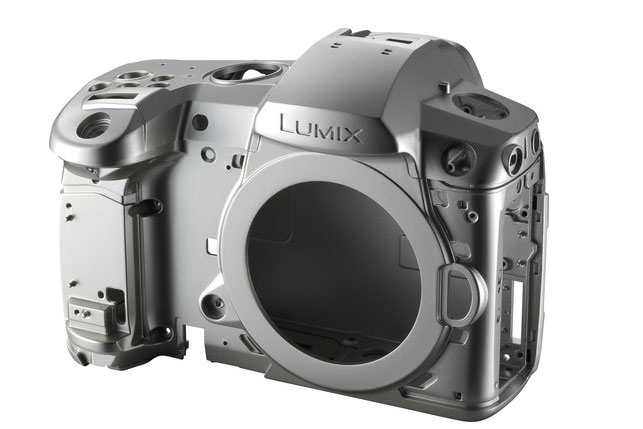
Panasonic has been one of the leading manufacturers of mirrorless cameras for many years, and the company’s GH series has been highly popular among professional photographers and videographers. In this article we will discuss the set of specs that may appear inside the Panasonic GH7 and its arrival date, we do hope and expect the upcoming GH series flagship camera is set to be a game-changer in the mirrorless camera market.
Panasonic GH Series announcement pattern
- GH1: March 2009
- GH2: September 2010
- GH3: September 2012
- GH4: February 2014
- GH5: January 2016
- GH5s: January 2018
- GH6: Feb 2022
- GH7: 2023 [Expected]
Live MOS Micro Four Thirds Sensor with Hybrid Auto Focus
One of the most highly-anticipated features of the GH7 is its hybrid AF sensor, yes we do believe this time we will have a Hybrid CMOS AF inside. This sensor will be a combination of both contrast-detection and phase-detection autofocus technologies just like we have seen in the recently announced Panasonic’s S5 Mark II camera and has received positive feedback from users. The inclusion of this technology in the GH7 camera will allow for faster and more accurate autofocus, making it a more attractive option for professional photographers and videographers who require high-performance cameras. The only Major Upgrade I Wish for inside the upcoming GH7 camera.
Well, that’s a topic of discussion, pixel peepers (like me) do love higher-resolution sensors at the same time some do believe that having a higher-resolution sensor means compromising with low-light performance of the camera. As we know the M4/3 formats-based sensors are 2X smaller than full frame sensors, so loading up more resolution won’t be feasible this time. A 40 MP higher resolution M4/3 format sensor should be preserved for Panasonic GH8 with 8K video resolution 😉
Rest Everything looks good inside the Panasonic GH series, which already features class-leading core specifications. If we talk about burst speed of 75fps of GH6 camera, 5.8K / 29.97p and 4K DCI / 119.88p RAW video data over HDMI that can be recorded as Apple ProRes RAW on the Atomos NINJA V and NINJA V+, and after the firmware v2.2 GH6 able to work with external SSDs with a capacity of up to 2TB, offering users fast storage at a fraction of the cost of CFexpress cards. This external storage is not only available for filmmakers or those shooting in ProRes, as all video formats can be saved to an SSD – as can still images. So, I think these features are already class-leading and don’t need that much improvement or upscaling, the only thing I am waiting for now is a massive upgrade in the AutoFocus system of the camera.
Do share your thoughts with us about the upcoming Panasonic GH7 camera.
Follow us on our social pages FACEBOOK | TWITTER | INSTAGRAM, to get LIVE News and Panasonic Rumor
By admin, on January 21st, 2023
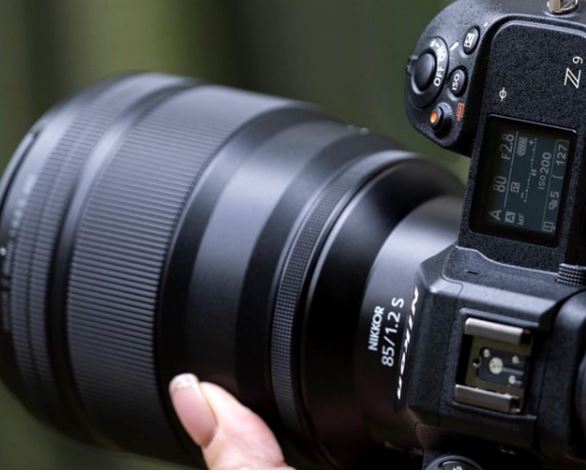
List of upcoming Nikon Mirrorless Lenses According Nikon Lenses Roadmap are
- NIKKOR Z 12-28mm DX PZ lens
- NIKKOR Z 24mm DX lens
- NIKKOR Z 26mm f/2.8 pancake lens (development announcement below)
- NIKKOR Z 35mm f/1.2 S lens
- NIKKOR Z 70-180mm f/2.8 lens (non-S)
- NIKKOR Z 85mm f/1.2 S lens (development announcement below)
- NIKKOR Z 135mm f/1.8 S lens
- NIKKOR Z 200-600mm f/6.3 lens (non-S)
NIKKOR Z 26mm f/2.8 pancake lens
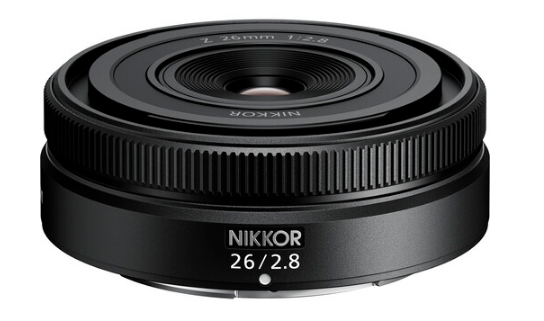
Details about Nikon 26mm Pancake Lens
The Nikon NIKKOR Z 26mm f/2.8 Lens is a must-have for advanced amateur photographers. This slim wide-angle prime lens is specifically designed for Nikon Z-series mirrorless cameras with full-frame sensor (FX format Lens). The lens boasts an impressive design that is both lightweight and compact, making it an excellent choice for photographers who are always on the go. With this lens, you’ll be able to capture stunning wide-angle shots without sacrificing portability. Additionally, its high rendering performance ensures that every photo will come out with stunning clarity and detail. Don’t miss a moment and take your photography to the next level with the Nikon NIKKOR Z 26mm f/2.8 Lens.
Lens also listed at B&H Sore
NIKKOR Z 85mm f/1.2 S lens
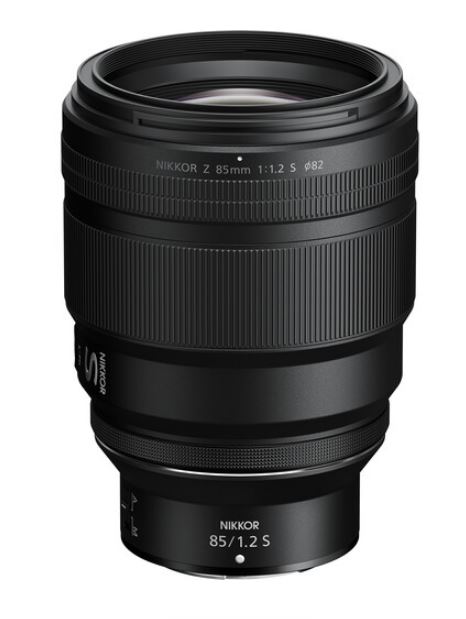
The to-be-announced Nikon Z 85mm f/1.2 S Lens is a top-of-the-line option for professional photographers and cinematographers. This ultra-fast, mid-telephoto prime lens is specifically designed for full-frame Nikon Z-series mirrorless cameras, and is part of Nikon’s elite S-Line of lenses. The lens has tremendous resolving power and is also compatible with upcoming higher-resolution sensors in the Nikon line-up ( Nikon Z8). The wide aperture of f/1.2 provides super smooth creamy bokeh, making this an ideal lens for portrait photography. Additionally, the lens offers excellent low-light performance and depth-of-field control. The lens is also built with advanced operability, making it easy to adjust focus, aperture, and other settings. If you’re looking for a premium lens that will take your portrait photography to the next level.
The Lens is already listed at B&H Store
And yes our latest buying guide Best Camera under the $1000 2023 list.
Follow us on our social pages FACEBOOK | TWITTER | INSTAGRAM to get live news + Nikon Rumors 24X7
sourc Nikonrumors
By admin, on January 20th, 2023

After the latest firmware update of the FX3 camera, users could not find the old Slog2 option in the menu. But, why this happened? The reason is very simple, the Slog 2 is limited to 8bit and Sony is no more interested in keeping the old recording 8bity format inside their camera.
Sony Slog 2 vs Slog 3
See, we have to understand this, S-LOG2 and S-LOG3 are both color spaces developed by Sony for use in their camera systems. But, S-LOG2 is the previous generation of the color profile and has some limitations,
- One of the main differences is the dynamic range that each color space can capture. S-LOG3 has a dynamic range of approximately 14 stops, which is wider than S-LOG2 which has a dynamic range of approximately 12 stops. This wider dynamic range allows for greater flexibility when grading and editing footage. Additionally, S-LOG3 has improved color accuracy and less noise in the shadows, which makes it a better option for professional videographers and photographers looking for the highest image quality.
- Another Major difference between the two is the bit depth. S-LOG2 is an 8-bit color space, while S-LOG3 is a 10-bit color space.
- S-LOG2 also has a gamma curve of 2.4, while S-LOG3 has a gamma curve of 2.8. A higher gamma curve like 2.8 of S-LOG3 allows for more room to work with in the highlights and shadows, less chance of clipping, more tonal gradations and subtle color variations, more precise representation of the scene’s brightness, and more control over the final look of the image or footage.
Latest Genrations of Slog 3
The first Sony camera to feature S-LOG3 was the Sony Alpha 7S II. It was announced in September 2015, but you also have to note that the Sony A7S II was using the first generation of Slog3, after that, we have two major updates over the original one and those are S-LOG3C, and S-LOG3G.
So, the S-LOG3C (sometimes written as SG3C ) is an updated version of S-LOG3, it’s a color space that is used in consumer cameras, a wider color gamut than S-LOG3 and it also includes a color matrix that is optimized for consumer cameras. The S-LOG3G is the latest version of S-LOG3, it’s a color space that is used in professional cameras and it’s been optimized for 8k resolution and high-frame-rate recording.
Sony FX3 Latest Fimrware Update
Before installing the update, please note and check the following:
Precautions when updating from Ver. 2.00 and Ver. 2.01
Updating to version 2.02 will delete the LUT (Look-Up Table) settings in the camera. Re-register the LUT settings after the update is complete.
Precautions when updating from Ver. 1.01 or earlier
- After updating to Ver. 2.00 or later, the camera settings will be reset to the default values.
Note: Since this update adds functions and makes major specification changes, the camera settings will be initialized as part of the update process. It is recommended that you make note of all the camera settings before proceeding. Even if you have saved the settings using the various save features available (such as Save/Load Settings and Save/Load FTP Settings) the settings before Ver. 1.01 cannot be read by the camera after the upgrade to Ver. 2.00 or later.
- With the addition of the log shooting mode, the picture profiles were reviewed and the gamma setting S-Log2 is no longer included. After the update, you will need to use the gamma setting S-Log3.
- You will be able to connect to the Imaging Edge Mobile app more easily. After pairing the app with the camera, you can transfer images and shoot remotely just by operating the app. Refer to Pairing the camera with a smartphone (Smartphone Regist.) in the Help Guide for detail. Along with this, the NFC one-touch connection function used up to Ver. 1.01 of the camera will no longer be available.
Note: You will also need to update the Imaging Edge Mobile app to Ver. 7.7 or later, and register as a new camera after the update.
Click here to download the update
Get Sony FX3 Camera from Amazon.com | B&H Store
Best Lenses for Sony FX3 – Sony 20-70 F4 | Sigma 85mm F1.4 ART
By admin, on January 16th, 2023
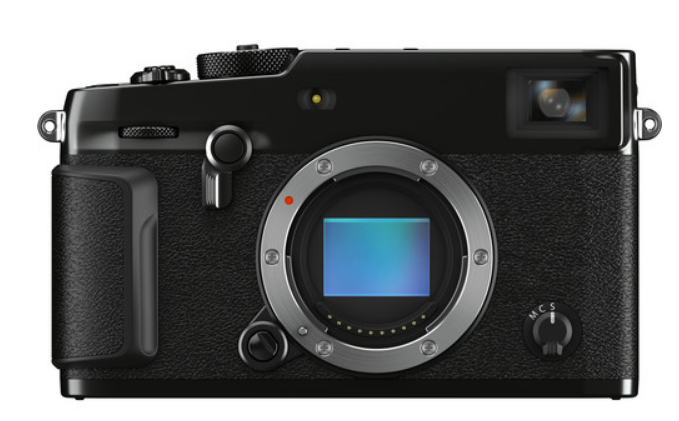
Finally, we have confirmed a set of information that the Fuji X-Pro 3 camera has been discontinued. Now, as a flagship model, the replacement will be arriving anytime soon. So, we have our own set of expectations with the Fuji X-Pro 4 Have a look
Fujifilm X-Pro 4 Specification [Expectations]
– 40MP APS-C X-Trans5 BSI Sensor
– 160MP Pixel Shift Multi-Shot
– 7-Stop In-Body Image Stabilization
– Image processing engine X Processor 5
– Faster than has been AF, low noise, excellent color reproduction
– Magnification automatic switching function equipped with advanced hybrid multi viewfinder
– The fastest shutter mechanical shutter 1/8000 seconds, electronic shutter 1/32000 seconds
– Synchro 1/250 sec
– Intelligent hybrid phase difference AF. AF point is 425 points
– Body of lightweight magnesium alloy. Dust and water specification
– LCD monitor three inches 1.62 million dot
– Dual SD Card slot (UHS-II compatible)
– ISO range of 125-12800
– Film Simulation mode 19
– Menu is new design. Customizable. My Menu function
– Lossless compression 14bit RAW
– Wi-Fi remote shooting
– Exposure compensation +/- 5 stage
– Interval Shooting
– 4k 60p 10-Bit Video
– FHD 240p 10-Bit Video
– The number of remaining shots is 600+ [approx]
Stay with us and we will update u soon as we get more info.
STAY WITH ON FACEBOOK | TWITTER | GOOGLE+ to get live news + Fuji rumors 24X7+
By admin, on January 10th, 2023
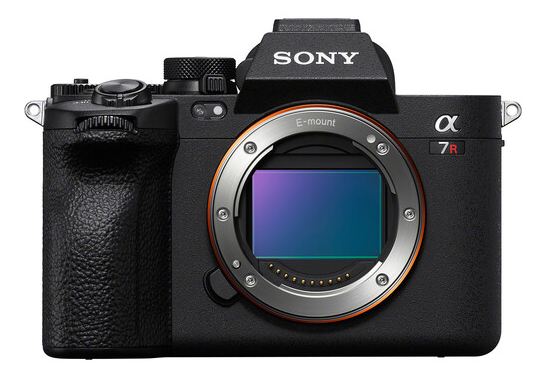
Sony A7R V camera image quality compared to Canon R5. Take a look at the image quality test between both cameras. Let’s do two HIGH ISO tests first then we will compare the details-capturing ability, its clearly visible that the Canon R5 is able to preserve more details compares to the Sony A7R V. We know that a professional will never use ISO 51200 in their camera. We are using such a high ISO range to show up the difference between the two.
So, from an initial set of comparison of the images of the two we can say that the Canon R5 camera is more recommended for uncontrolled light environments.
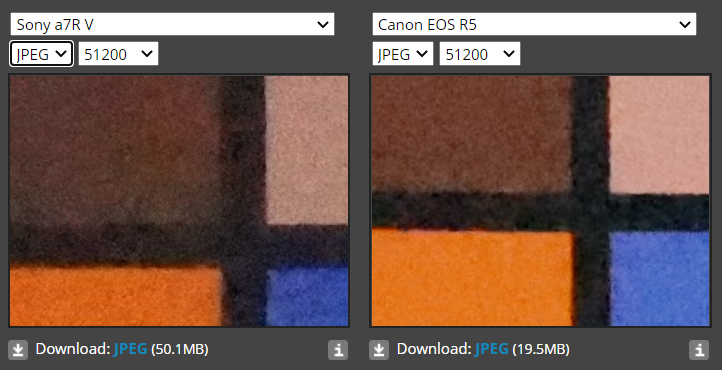
Sony A7R V is able to grab more details at base ISO, but the difference is only visible when viewed at 100%. The difference is quite logical since the Canon R5 camera features a 45MP Full-Frame CMOS Sensor and the Sony A7R 5 camera uses 61MP Full-Frame Exmor R BSI CMOS Sensor. So, here we are witnessing the difference in the details capturing ability of both cameras.

Sony A7R V Pixel shift mode 240.8MP
When you will use the Pixel shift mode 240.8MP, of ur Sony A7R V camera, you get an enormous amount of details . As you can see in the image below. The file size is also incredible jpeg is approx 150MB and the RAW is approx 1 GB.
Who Will use this mode?
If you are a studiographer or working with lights, then undoubtedly the Sony A7 R V is an amazing option for you.
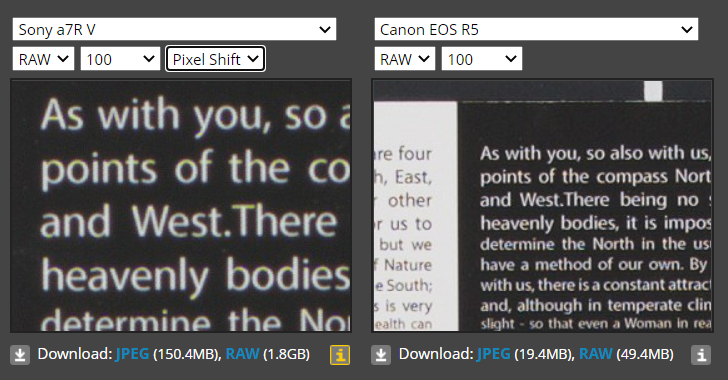
Best Camera for Photographers
If you are into Wildlife and sports then you should get the Canon R5 Camera. Since as you know the Sony A7R V is limited to 10FPS mode at the same time the Sony third-party lenses are also limited to a 15FPS limit. So, if you are into sports and wildlife then the only option is Canon R5 (yes Canon RF mount is locked, but the Canon old L Series DSLR lenses support burst speed up to 30 to 4 Fps.)
Feeling of ecstasy with A7R V possible
If you are not connected to Sports and Wildlife. The most recommended camera will satisfy pixel craving and if you use the pixel shift mode then the result will give you goosebumps and u will feel a state of complete ecstasy within yourself. That’s the most perfect camera sony ever created for pixel peepers like us.
Get ur A7R V Amazon Sony A7R V | B&H Store
Also, see – Top 10 Best Sony Cameras of 2022
Follow us on our social pages FACEBOOK | TWITTER | INSTAGRAM, If you have time –>see more Sony Alpha Rumor
Source and Special thanks to dpreview lab
By admin, on January 6th, 2023
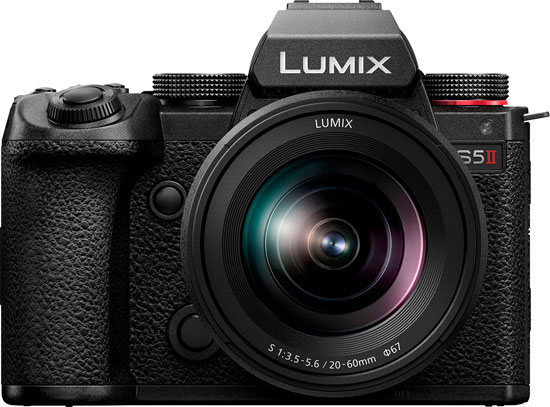
Panasonic S5 Mark II vs Canon R6 Mark II – Both of these cameras features the same sensor resolution, but as usual, the Canon R6 Mark II features advanced AI AF for fast-tracking and the Jpeg burst speed of the R6 Mark II touches the 40fps mark. Although the buffer capacity of the Canon is just half of the Panasonic S5 Mark II and u can store up to a Max of 70-100 image files in a single burst with Canon.
1. Senor and AF System
We are comparing the two specifications. Panasonic S5 mark II camera features a newly developed 24MP Sensor with Phase detect AF points and support of DFD still there. The Max burst speed of the Panasonic S5 Mark II is 30fps with an electronic shutter and the expandable ISO range is 50-204800. Since it’s Panasonic’s first full-frame camera so, we are not expecting blazing-fast AF performance like Canon R6 Mark II, but at least we will get a more accurate and fast AF system compared to its predecessor the Panasonic S5.
| Lens Mount |
Panasonic S5 Mark II |
|
Canon R6 Mark II |
| Sensor Resolution |
Actual: 25.28 Megapixel
Effective: 24.2 Megapixel (6000 x 4000) |
|
Actual: 25.6 Megapixel
Effective: 24.2 Megapixel (6000 x 4000) |
| Sensor Type |
35.6 x 23.8 mm (Full-Frame) CMOS |
|
35.9 x 23.9 mm (Full-Frame) CMOS |
| Image Stabilization |
Sensor-Shift, 5-Axis |
|
Sensor-Shift, 5-Axis |
| Built-In ND Filter |
None |
|
None |
| Capture Type |
Stills & Video |
|
Stills & Video |
|
Panasonic S5 Mark II |
|
Canon R6 Mark II |
| Shutter Type |
Mechanical Focal Plane Shutter, Electronic Shutter |
|
Electronic Shutter, Mechanical Focal Plane Shutter |
| Shutter Speed |
Mechanical Shutter
1/8000 to 60 Seconds
Up to 30 Minutes in Bulb Mode
Electronic Front Curtain Shutter
1/2000 to 60 Seconds
Up to 30 Minutes
Electronic Shutter
1/8000 to 60 Seconds
Up to 60 Seconds in Bulb Mode
1/16000 to 1/25 Second in Movie Mode |
|
Mechanical Shutter
1/8000 to 30 Seconds
Electronic Shutter
1/16000 to 30 Seconds |
| Bulb/Time Mode |
Bulb Mode |
|
Bulb Mode |
| ISO Sensitivity |
Photo
100 to 51,200 in Auto Mode (Extended: 50 to 204,800)
Video
100 to 51,200 |
|
100 to 102,400 in Manual, Auto Mode (Extended: 50 to 204,800) |
| Metering Method |
Center-Weighted Average, Highlight Weighted, Multi-Zone, Multiple, Spot |
|
Center-Weighted Average, Evaluative, Partial, Spot |
| Exposure Modes |
Aperture Priority, Manual, Program, Shutter Priority |
|
Aperture Priority, Manual, Program, Shutter Priority |
| Exposure Compensation |
-5 to +5 EV (1/3 EV Steps) |
|
-3 to +3 EV (1/3, 1/2 EV Steps) |
| Metering Range |
0 to 18 EV |
|
-3 to 20 EV |
| White Balance |
Presets: Auto, Cloudy, Color Temperature, Daylight, Flash, Incandescent, Shade, White Set |
|
Presets: Auto, Cloudy, Color Temperature, Custom, Daylight, Flash, Fluorescent (White), Shade, Tungsten |
| Continuous Shooting |
Mechanical Shutter
Up to 9 fps at 24.2 MP for up to 999 Frames (Raw) / 1000+ Frames (JPEG)
Electronic Shutter
Up to 30 fps at 24.2 MP for up to 199 Frames (Raw) / 299+ Frames (JPEG) |
|
Mechanical Shutter
Up to 12 fps at 24 MP for up to 1000 Frames (JPEG) / 110 Frames (Raw)
Electronic Shutter
Up to 40 fps at 24 MP for up to 190 Frames (JPEG) / 75 Frames (Raw) |
| Interval Recording |
Yes |
|
Yes |
| Self-Timer |
2/10-Second Delay |
|
2/10-Second Delay |
2. Open Gate 6k 60FPS
Both of the camer able to record 6k video, but only Canon R6 Mark II with a faster image processor is able to shoot 6k 60fps and the Panasonic S5 Mark II remains limited to 6k 30fps in 4:2:2 10bit mode. The only issue with Canon is the output the 6K output is available only via the HDMI port.
3. Crippled 4k 60fps? 1.5X Crop in Panasonic S5 Mark II
Canon R6 Mark II Camera is able to shoot up to 4k 60fps uncropped which isn’t possible with the Panasonic S5 mark II camera since it’s limited to 4k 1.5x crop. So, if you like to shoot 4k HQ some music videos, or anything fast u would like to shoot to 4k 60fps.
4. Cooling vents in Panasonic S5 Mark II
Canon R6 mark II camera doesn’t overheat while shooting 4k 24 or 30 fps, but while you are shooting 4k @ 60fps you may face some overheating issues while shooting in hot and humid conditions. At the same time, the Panasonic S5 Mark II camera features an advanced heat sink unit and cooling vents. but, at the same time, 4k 60fps is heavily crippled and the camera doesn’t do full sensor readout while shooting 4k 60fps. So, yes in a way we do have some added advantages of cooling vents in Panasonic S5 Mark II, but they are not that useful due to cropped 4k 60fps, better to get R6 Mark II if ur interested in recording uncropped oversampled 4k.
5. DUAL NATIVE ISO
Dual native ISO isn’t a new feature in Panasonic S5 Mark II, even the Panasonic S5 was having from ISO 640 – 4000 in VLOG. I don’t know the exact reason why these camera makers (Sony and Canon) hide the Dual Native ISOs in their Pro Cameras like Canon R6 Mark II or A74, btw the sensor of both the camera uses dual Native ISO circuits, and during HIGH ISO test it’s visible to the Dual Native ISO high gain and low gain circuit working on the backend of the camera. But, in the end, the open Dual Native ISO Menu inside the Panasonic S5 Mark II camera makes it more usable for low-light situations.
6. Timecode | Waveforms | Live LUTS | Vectorscope
These are some essential ingredients for professional cinematographers out there, all these are only available in Panasonic S5 Mark II Camera and not in Canon R6 Mark II.
| |
Panasonic S5 mark II |
|
Canon R6 Mark II
|
| 6K |
6k 24, 30 fps internal |
|
6k 24 60 FPS HDMI |
| Internal Recording Mode |
[6K] 5952×3968 (3:2):
29.97p, 200Mbps (4:2:0 10-bit LongGOP) (H.265/HEVC, LPCM)
6K] 5952×3136 (17:9):
29.97p, 200Mbps (4:2:0 10-bit LongGOP) (H.265/HEVC, LPCM)
[5.9K] 5888×3312 (16:9) at 29.97p, 200Mbps
[C4K] 4096×2160 at 29.97p, 150Mbps
[4K] 3840×2160 at 29.97p, 150Mbps
[FHD] 1920×1080 at 119.88p, 150Mbps |
|
External 6K 60 FPS ProRes RAW Recording
H.264/H.265/MPEG-4 4:2:2 10-Bit
UHD 4K (3840 x 2160) at 23.98/25/29.97/50/59.94 fps [60 to 340 Mb/s] 1920 x 4K60 10-Bit Internal Video, C-Log 31080 at 23.98/25/29.97/50/59.94/100/119.88/150/179.82 fps [12 to 270 Mb/s] |
| 4k 60fps |
1.5x Crop / APS-C Crop |
|
Uncropped |
| Dual Native ISO |
Yes |
|
No |
| Time Code |
Yes |
|
No |
| Audio Recording |
AAC Audio
LPCM Audio |
|
LPCM Audio
AAC Audio |
Interface
|
Panasonic S5 Mark II |
Sony A74 |
| Media/Memory Card Slot |
Slot 1: SD/SDHC/SDXC (UHS-II)
Slot 2: SD/SDHC/SDXC (UHS-II) |
Dual Slot: SD/SDHC/SDXC (UHS-II) |
| Video I/O |
1 x HDMI Full Size (Type A) Output |
1 x Micro-HDMI Output |
| Audio I/O |
1 x 1/8″ / 3.5 mm TRS Stereo Headphone Output
1 x 1/8″ / 3.5 mm TRS Stereo Microphone Input |
1 x 1/8″ / 3.5 mm TRS Stereo Microphone Input on Camera Body
1 x 1/8″ / 3.5 mm TRS Stereo Headphone Output on Camera Body |
| Power I/O |
1 x USB-C Input/Output |
1 x USB-C Input |
| Other I/O |
1 x USB-C (USB 3.2 / 3.1 Gen 1) Data Input/Output (Shared with Power Input)
1 x 2.5 mm Sub-Mini Control Input |
1 x USB-C (USB 3.2 / 3.1 Gen 2) Data/Tether Input/Output (Shared with Power Input) |
| Wireless |
Bluetooth, Wi-Fi |
2.4 / 5 GHz Wi-Fi 5 (802.11ac) Control
Bluetooth |
| Global Positioning (GPS, GLONASS, etc.) |
None |
No
*As of November, 2022: Check with manufacturer for the most up-to-date compatibility |
|
|
None |
Monitor
|
Panasonic S5 Mark II |
Sony A74 |
| Size |
3.0″ |
3.0″ |
| Resolution |
1,840,000 Dot |
1,620,000 Dot |
| Display Type |
Articulating Touchscreen LCD |
Articulating Touchscreen LCD |
Viewfinder
|
Panasonic S5 Mark II |
Sony A74 |
| Type |
Built-In Electronic (OLED) |
Built-In Electronic (OLED) |
| Resolution |
3,680,000 Dot |
3,690,000 Dot |
| Eye Point |
21 mm |
23 mm |
| Coverage |
100% |
100% |
| Magnification |
Approx. 0.74x |
Approx. 0.76x |
| Diopter Adjustment |
-4 to +4 |
-4 to +2 |
Focus
|
Panasonic S5 Mark II |
Sony A74 |
| Focus Type |
Auto and Manual Focus |
Auto and Manual Focus |
| Focus Mode |
Continuous-Servo AF, Manual Focus, Single-Servo AF |
Continuous-Servo AF, Manual Focus, Single-Servo AF |
| Autofocus Points |
Phase Detection: Yes
Contrast Detection: 225 |
Photo, Video
Contrast Detection, Phase Detection: 1053 |
| Dedicated Object AI AF Modes |
No |
Yes |
| Autofocus Sensitivity |
-6 to +20 EV |
-6.5 to +21 EV |
General
|
Panasonic S5 Mark II |
Sony A74 |
| Battery Type |
1 x DMW-BLK22 Rechargeable Lithium-Ion, 2200 VDC, 7.2 mAh (Approx. 440 Shots) |
1 x LP-E6NH Rechargeable Lithium-Ion, 7.2 VDC, 2130 mAh (Approx. 760 Shots) |
| HDMI Type |
Full Size |
Micro HDMI |
| Tripod Mounting Thread |
1 x 1/4″-20 Female (Bottom) |
1 x 1/4″-20 Female (Bottom) |
| Dimensions (W x H x D) |
5.22 x 3.82 x 3.22″ / 132.6 x 97.1 x 81.9 mm |
5.4 x 3.9 x 3.5″ / 138.4 x 98.4 x 88.4 mm |
| Weight |
657 g (Body Only) |
657 g (Body Only) |
Verdict: For Photographer and content creators Canon R6 Mark II is more recommended and for professional cinematographers Panasonic S5x Mark II.
By admin, on January 4th, 2023

Panasonic S5 mark II camera features a newly developed 24MP Sensor with Phase detect AF points and support of DFD still there. The Max burst speed of the Panasonic S5 Mark II is 30fps with an electronic shutter and the expandable ISO range is 50-204800. Since it’s Panasonic’s first full-frame camera so, we are not expecting blazing-fast AF performance like Sony A7 IV, but at least we will get a more accurate and fast AF system compared to its predecessor the Panasonic S5.
Panasonic S5 Mark II Price $1997 B&H Store
Global shipping is to start on Jan 31, 2023.
Panasonic S5 Mark II Press Release
Panasonic Announces Highly-Anticipated LUMIX S5II and S5IIX at Consumer Electronics Show 2023
The S5II and S5IIX utilize Phase Detection Auto-Focus (PDAF), satisfying the demand for the feature in LUMIX mirrorless cameras
Las Vegas, NV (January 4, 2023) – Panasonic is proud to announce two new hybrid full-frame mirrorless cameras, the LUMIX S5II and S5IIX, as the latest additions to its LUMIX S Series camera line-up. The LUMIX S5II and S5IIX are the first LUMIX mirrorless cameras to utilize Phase Detection Auto-Focus (PDAF) thanks to a newly developed 24.2-megapixel 35mm full-frame CMOS sensor and a new imaging engine. Developed under the L² Technology alliance formed by LEICA and LUMIX earlier this year, the new imaging engine provides high resolution, natural description, and approximately 2x higher-speed signal procession for high bit-rate video recording. To further the cameras’ PDAF capabilities and make them more dependable, Panasonic evolved the auto-focus system into Phase Hybrid Auto-Focus by increasing the AF points to 779 to significantly improve subject tracking. Once the S5II and S5IIX are locked on a subject, the auto-focus will continue to track the subject, even in adverse lighting conditions and when multiple objects are moving within the frame. Additionally, continuous AF during zooming*1, AF micro adjustments, and options to decrease the size of the AF area are available.
The LUMIX S5II and S5IIX have a powerful image stabilization system for wide-ranging shooting conditions and situations. The Body I.S. (5-axis) in the LUMIX S5II and S5IIX I and the O.I.S. (Optical Image Stabilizer, 2-axis) from the LUMIX S Series lens were combined to create the 5-axis Dual I.S. 2, maximizing the correction power to allow 6.5-stop slower shutter speed*2. The 5-axis Dual I.S. 2 works for both photo and video recording, including 4K. In addition, Active I.S. has been added for even more stable video recording. Active I.S. optimizes the horizontal, vertical, and rotational correction ratios by determining the status of the camera shake. As a result, the performance of the image stabilizer can account for a larger amount of camera shake at approximately 200%*3 compared to conventional image stabilization. This capability is highly beneficial in adverse situations, such as handheld filming or telephoto fixed-frame shots.
The new imaging engine provides the LUMIX S5II and S5IIX with high video performance comparable to the LUMIX S1H. They provide 4:2:0 10-bit 6K (3:2) / 5.9K (16:9), unlimited 4:2:2 10-bit C4K/4K recording capability*4. With a new heat-dispersion mechanism, there is no limit on recording time to avoid overheating*5. HFR (High Frame Rate) in C4K/4K (48p), FHD (120p), Slow & Quick motion in C4K/4K(1-60fps) / FHD(1-180fps) are also available. The LUMIX S5II and S5IIX contain 14+ stop V-Log/V-Gamut capture to deliver a high dynamic range and broad colors. Plus, a REAL TIME LUT function is provided to enable color grading on the compatible video and photo in the camera by applying the LUT(.VLT/.cube) saved in the SD memory card. Users can perform intended color grading on the spot without postproduction and share images online through social networking sites. This function can be used for live streaming.
Packing the essence of LUMIX S Series cameras into a compact, lightweight body, the LUMIX S5II and S5IIX have further evolved to meet the demands of all creators. The LUMIX S5II is $1,999.99 and will be available in January 2023. The LUMIX S5IIX is $2,199.99 and will be available in May 2023.
- Professional-quality photo/video performance for unlimited expression
In addition to the PDAF capabilities mentioned above, the LUMIX S5II and S5IIX provide:
- Dual Native ISO sensitivity minimizes noise generation by choosing an optimal circuit to use according to the sensitivity before gain processing. As a result, it allows a maximum ISO 51200 (Extended: 204800) high-sensitivity recording.
- Increased capability of higher speed burst shooting at 9 (AFS) / 7 (AFC) fps with a mechanical shutter and 30 fps (AFS/AFC) with an electronic shutter in JPEG/RAW compared with LUMIX S5.
- A variety of video functions and recording options
Alongside the recording capability, new heat dispersion mechanism and 14+ stop V Log/V Gamut capture mentioned above, the LUMIX S5II and LUMIX S5IIX feature unique shooting options such as the 4K60p interval shooting and 4K HDR video recording. In response to requests from professional users, video assist functions such as Waveform Monitor, Vector Scope and Zebra Pattern are available. Some features offered on the LUMIX S1H and LUMX GH6, like System Frequency (24.00Hz), Synchro Scan, Fan mode and redesigned control panel, which enables quick selection of menu, are also available on the LUMIX S5II and S5IIX.
48kHz/24bit audio can be recorded using a built-in microphone and external microphone for realistic sound recording. The use of the external microphone and XLR microphone allows high-res 96kHz/24bit audio recording.
The LUMIX S5IIX is capable of RAW video output and All-Intra, ProRes*8 recording on SSD. It also features a wired*9/wireless IP streaming function and USB tethering.
- Excellent operability and functions to minimize workflow for one-man crew operation
Building upon the functionality of the LUMIX S5, a wealth of options was added to the LUMIX S5II and S5IIX to provide users with a superior shooting experience. AWB Lock maintains the white balance set in auto. Sheer Overlay can now be used in Creative Video mode making it easy to fix the frame through the footage sequence. The luminance level of 2100 Like (HLG) in Photo Style for video has an extended setting range from 64-940 to 0-1023, providing a sufficient amount of color grading resistance. In addition to FHD, it is now possible to output a 4K image with the live crop function. To support high-precision focusing, the LUMIX S5II and S5IIX provide practical options for manual focusing. While the focus is shifted with a variable amount according to the rotation speed of the focus ring for a non-linear setting, it is shifted with a designated amount according to the rotational quantum of the focus ring for a linear setting. Sensitivity (amount of focus shift per rotational quantum) can be selected from 90 to 1080 degrees to enable the intended focus operation. The MF Assist, which enables the focus point to be enlarged, is now available in both photo shooting and video recording*10.
The LUMIX S5II and S5IIX adopt a large, 3,680K-dot OLED (Organic Light-Emitting Diode) LVF (Live View Finder) that features a high magnification ratio of approx. 1.52x / 0.76x (35mm camera equivalent). A 3.0-inch free-angle touch-control monitor in 3:2 aspect with 1,840K-dot high resolution does not cause interference even when both the HDMI cable and USB cable are connected by adjusting the tilt/rotation angle of the monitor. There are improvements in external design, including a new easy-to-operate 8-directional joystick and the drive dial with an increased setting position for 96-megapixel High-Resolution Mode (JPEG/RAW).
- Reliable quality and performance for professional use and connectivity
Overheating is a fatal issue to continuous video recording, especially when the resolution and frame rates are increased. The LUMIX S5II and S5IIX adopt a new heat dispersion mechanism that combines a small fan and a high-efficiency heat sink. As a result, the LUMIX S5II and S5IIX achieve unlimited video recording time*11*12 and livestreaming*13 in C4K 60p while keeping the camera size compact. In case the camera stops while 4K video recording, the small fan operates separately to cool down the unit for quick recovery.
To withstand heavy field use, the LUMIX S5II and S5IIX are composed of a magnesium alloy full die-cast front / rear frame and are splash-resistant*14 and dust-resistant.
For the terminal, HDMI Type A is provided. Plus, a cable lock holder for the HDMI/USB cable is bundled to prevent issues such as unplugging on location. The LUMIX S5II and S5IIX support USB 3.2 Gen 2 for high-speed writing and readout. The LUMIX S5II and S5IIX are equipped with double card slots (UHS-II x 2). Users can choose the recording method from Relay Recording, Backup Recording, and Allocation Recording. For the external microphone, a Φ3.5mm stereo jack and a headphone jack are provided.
Wi-Fi 5 GHz (IEEE802.11ac)*15 and 2.4 GHz (IEEE802.11b/g/n) effectively provide a- secure and stable connection on smartphones, tablets, and other devices on location for smooth remote control. The transmission speed of photo/video data is also increased by using the 5 GHz bands. Compatibility with Bluetooth 5.0 (called BLE: Bluetooth Low Energy) enables constant connection with a smartphone or tablet with minimum power consumption. The settings of the LUMIX S5II and S5IIX cameras can be copied and transmitted wirelessly to other LUMIX S5II and S5IIX cameras when using multiple LUMIX S5II and S5IIX cameras. The LUMIX Sync application for iOS/Android devices allows remote control of the camera using a smartphone or a tablet via an easy wireless connection. In addition to wireless control via a Remote Shutter DMW-RS2 (sold separately), application software LUMIX Tether enables tethered shooting via USB. Users can control the camera by connecting it to a PC via USB. It lets them view the image on a large PC screen while shooting.
The camera’s 2200mAh high-capacity battery DMW-BLK22 can be recharged either via AC or USB according to the user’s convenience. It also complies with USB PD (Power Delivery) when the corresponding Battery Charger DMW-BTC15 (sold separately) is used. Battery Grip DMW-BGS5 (sold separately) can be used in common with LUMIX S5.
Dressed in an exceptional matte black profile, the LUMIX S5IIX boasts an exceptionally sleek, stylish design while the S5II takes on the authentic look as the predecessor.
- The best assortment of S PRO /S full-frame lenses
The Panasonic LUMIX S Series boasts a total lineup of 14 lenses including the new LUMIX S 14-28mm F4-5.6 MACRO (S-R1428) according to the purpose. Moreover, the L-Mount system provides the best assortment of full-frame lenses to choose from, for the limitless spectrum of creative possibilities. Color shading correction helps improve image quality when other manufacturers’ lenses including old lenses are used with or without using a Mount Adaptor. Furthermore, LUMIX S5II and S5IIX memorize the name and its focal length of analog lenses such as anamorphic lenses or old lenses to provide a suitable setting of the camera’s in-body image stabilizer automatically when those lenses are used.
- Future firmware update
To enhance the performance of LUMIX S5II and S5IIX, the functions below will be available with future firmware updates following the needs of customers.
- RAW data output using Software Upgrade Key DMW-SFU2 (S5II)
- Live View Composite (S5II) and more.
|
KEEP THIS BLOG ALIVE - Support New Camera Buy Canon Lenses, Buy Music CD or Digital Camera at amazon it helps this site, and you do not pay anything extra, it is just a way to help support this site.

|















